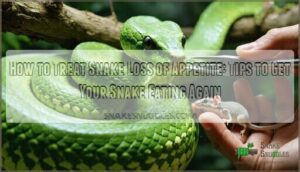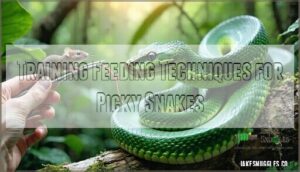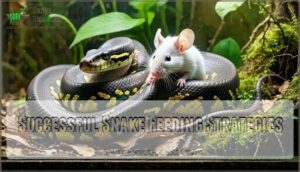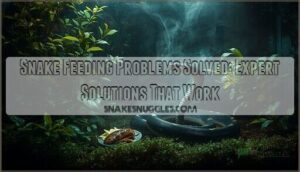This site is supported by our readers. We may earn a commission, at no cost to you, if you purchase through links.

Stress from improper conditions kills appetite faster than you’d think. Try switching prey types or sizes, and consider scenting food with something more appealing.
Remove distractions during feeding time and give your snake privacy. Some snakes go off food during breeding season or shedding cycles – this is normal.
If environmental factors check out, health issues might be the culprit. The key to how to treat snake loss of appetite lies in methodical troubleshooting, starting with the most common causes and working your way through specific techniques that even veteran keepers swear by.
Table Of Contents
- Key Takeaways
- Snake Appetite Factors
- Treating Snake Loss Appetite
- Stimulating Snake Appetite
- Addressing Snake Eating Problems
- Successful Snake Feeding Strategies
- Frequently Asked Questions (FAQs)
- What to do if my snake is struggling to eat?
- How do you stimulate a snake to eat?
- Why is my snake all of a sudden not eating?
- How to treat anorexia in snakes?
- What to do when your snake isn’t eating?
- How do you increase a snake’s appetite?
- How long is too long for a snake to not eat?
- How do you treat anorexia in snakes?
- What are signs my snake is healthy again?
- How often do snakes typically eat?
- Conclusion
Key Takeaways
- Check your husbandry basics first – proper temperature gradients, humidity levels, and hiding spots are essential since environmental stress kills appetite faster than you’d think
- Try switching prey types, sizes, or presentation methods – consider scenting food with appealing odors, using frozen vs. live options, or feeding at dusk when snakes naturally hunt
- Don’t panic over seasonal fasting – many snakes naturally refuse food during breeding season or shedding cycles, which is completely normal behavior
- Use systematic troubleshooting rather than rushed fixes – monitor your snake’s behavior, weight, and overall condition while methodically addressing the most common causes before moving to specialized techniques
Snake Appetite Factors
When your snake suddenly stops eating, you’re probably wondering what’s going wrong.
A hungry snake that suddenly refuses food is trying to tell you something important.
Several key factors can affect your snake’s appetite, from environmental conditions and health issues to breeding cycles and basic husbandry mistakes.
Environmental Factors Affecting Appetite
Your snake’s environment substantially affects its appetite.
Temperature gradients must be correct – too hot or cold can cause snake anorexia. Proper humidity levels, adequate enclosure size, and consistent lighting schedules all impact feeding.
Seasonal changes naturally affect reptile appetite loss, so don’t panic if your snake refuses food during certain months, due to seasonal changes.
Health Issues Impacting Eating Habits
Beyond environmental factors, various health problems can cause your snake to stop eating.
When your snake refuses food, it’s often signaling an underlying medical issue that needs attention.
Here are common health issues that impact snake appetite:
- Parasite Infections – Intestinal worms and protozoa cause digestive problems and weight loss
- Mouth Rot – Bacterial infections create painful sores, making eating difficult
- Respiratory Illnesses – Breathing problems lead to wheezing and food refusal
- Impaction Issues – Blocked digestive tract prevents normal eating patterns
- Metabolic Disorders – Nutritional deficiencies affect overall health and appetite
These conditions require veterinary diagnosis and treatment to restore your snake’s eating habits. If your snake isn’t eating, it may also be experiencing discomfort during shedding.
Breeding Season Effects on Appetite
During breeding season, hormonal changes dramatically affect your snake’s eating habits.
Males often refuse food completely while focused on mating rituals, spending their energy searching for females instead of feeding.
Gravid females may also show loss of appetite as their bodies prioritize egg development.
Post-laying appetite typically returns once breeding stress subsides and normal snake behavior resumes.
Ensuring adequate nutrition is key, and calcium supplementation can be beneficial during this period to support the snake’s overall health and breeding success.
Husbandry Practices Role in Eating Problems
Poor husbandry creates a domino effect of feeding problems.
Incorrect temperature gradients stress your snake, while wrong humidity levels affect digestion. Cramped enclosure size, inappropriate substrate choices, and insufficient hiding spots all contribute to snake not eating episodes.
When your snake’s refusing food, examine these basics first. Proper snake care tips start with getting the environment right—it’s often the simplest fix for snake feeding problems and loss of appetite.
Treating Snake Loss Appetite
When your snake refuses to eat, you’ll need to figure out what’s wrong and take action quickly.
A hungry snake needs quick action—spot the problem and fix it fast.
This process involves watching for specific signs, understanding the difference between normal fasting and serious problems, and finding the real reason behind their appetite loss.
Identifying Hunger and Fullness Cues
Learning to spot when your snake’s hungry or full takes practice, but it’s easier than you’d think.
Watch these key Hunger Signals and Fullness Signs:
- Tongue flicking increases – Your snake samples the air more frequently when seeking food
- Restless movement patterns – Active exploration around feeding areas signals hunger
- Weight Changes become noticeable – Gradual weight loss indicates need for feeding
- Activity Levels shift dramatically – Hungry snakes show increased movement before meals
- Shedding Impact reduces appetite – Snakes typically refuse food during pre-shed cycles
Understanding these snake eating habits helps prevent snake feeding problems and addresses concerns when your snake’s not eating or refusing food.
Recognizing Signs of Anorexia in Snakes
When your snake refuses food for weeks, certain red flags signal serious trouble.
Watch for these critical warning signs that separate normal fasting from dangerous anorexia.
| Physical Signs | Behavioral Signs |
|---|---|
| Weight Loss (visible spine/ribs) | Lethargy Observed during handling |
| Regurgitation Signs after meals | Hiding Behavior increases dramatically |
| Shedding Issues (stuck shed) | Snake refusing food consistently |
| Sunken eyes or dehydration | Loss of defensive responses |
| Muscle wasting along body | Unusual positioning or postures |
Snake anorexia differs from normal fasting patterns.
Healthy snakes maintain body condition during seasonal fasts, while sick reptiles show progressive decline.
When your reptile wont eat and displays multiple symptoms, snake health issues require immediate attention to prevent life-threatening complications.
Determining Root Cause of Loss Appetite
Looking at your content once your snake shows signs of anorexia, you’ll need to dig deeper to find what’s causing the problem.
Parasites, infections, or impaction could be making your snake uncomfortable and refusing food.
Stress from poor husbandry, tumors, or other snake health issues also trigger snake diet problems.
A veterinarian can identify these snake nutrition concerns through proper examination and testing for effective snake veterinary care, addressing issues like anorexia.
Stimulating Snake Appetite
When your snake refuses to eat, you’ll need to try different approaches to spark their interest in food.
These methods can help turn even the pickiest snake into a enthusiastic eater again.
Changing Food Types and Presentation Methods
Your snake’s appetite challenges might vanish with simple food swaps. Try switching from mice to rats or adjusting prey size to match your snake’s head diameter.
Live vs. frozen options can spark interest, while food color variations may appeal to picky eaters. Scent enhancement using chicken broth creates irresistible aromas.
Different presentation styles—like using feeding forceps or warming prey—can trigger natural feeding responses, effectively treating snake anorexia without assist feeding.
It’s key to remember that snakes are carnivores, and their diet varies widely depending on species.
Using Trickery to Encourage Eating
Sometimes you need to outsmart a stubborn snake. Brain confusion works when you wiggle prey with feeding tongs, mimicking live movement. Visual deception helps too—try different lighting or feeding at dusk when many species naturally hunt.
Temperature tricks can jumpstart appetite; slightly warm the prey item. Scent masking with a preferred prey’s smell often works wonders. Proper humidity levels also support digestive health.
These methods beat force feeding snake attempts, which stress your pet. Smart appetite stimulants through trickery often resolve snake feeding strike issues naturally.
Training Feeding Techniques for Picky Snakes
By gently encouraging reluctant eaters, you’ll build trust while addressing feeding challenges.
Target Training involves gradually teaching your snake to accept prey through consistent presentation methods. Use Assist Feeding for snakes that strike but won’t consume, gently guiding prey toward their mouth.
Try Prey Wiggling to trigger natural hunting instincts, making dead prey appear alive. Implement Gradual Changes in feeding schedules or prey size rather than sudden switches when treating snake anorexia, using techniques like Target Training to help your snake.
Scenting and Its Role in Stimulating Appetite
When training methods fall short, scenting offers another powerful approach for treating snake anorexia.
This technique taps into your snake’s natural prey detection instincts through their highly developed scent gland secrets system.
- Natural Prey Odors: Rub prey scent directly onto frozen food items to mimic wild hunting experiences
- Prey Scent Strength: Start with subtle scenting and gradually increase intensity based on your snake’s response
- Artificial Scent Safety: Use only commercial reptile scenting products to avoid harmful chemicals or toxins
- Scenting Frequency: Apply fresh scent before each feeding attempt for maximum effectiveness
- Species-Specific Approach: Match scents to your snake’s natural diet preferences for better results
This reptile feeding solution works by activating your snake’s vomeronasal organ, triggering their hunting instincts even when they’re reluctant to eat.
You can find a variety of snake scenting products online.
Addressing Snake Eating Problems
When your snake won’t eat, you’ll need to try different approaches to identify what works best for your specific situation.
The key is staying patient and methodical as you work through various solutions to get your snake back on track with regular feeding.
Experimenting With Different Food Types
When you’re dealing with a stubborn snake, switching up the menu can work wonders.
Try offering different prey sizes or switching between live vs. frozen options.
Food variety matters—some snakes prefer rats over mice, while others might need scent enhancement to spark interest.
| Food Type | Benefits | Best For |
|---|---|---|
| Smaller prey items | Easier to digest, less intimidating | Young or stressed snakes |
| Different species (rats vs mice) | Varied nutritional value, new textures | Picky eaters |
| Scented prey | Enhanced appeal, triggers feeding response | Snakes refusing food |
| Live vs frozen options | Mimics natural hunting, convenience factor | Species-specific preferences |
Your snake’s appetite stimulation often depends on finding the right combination.
Sometimes, exploring non-rodent food alternatives can also help stimulate appetite.
Some snakes need the movement of live prey to trigger their feeding response, while others do fine with properly thawed frozen options.
Snake care involves understanding these individual preferences—what works for one snake mightn’t work for another.
Pay attention to prey size relative to your snake’s head diameter.
Snake diet success often comes down to matching the right food variety with your pet’s specific needs and feeding issues.
Implementing Trickery and Training Feeding
When food types alone won’t work, you’ll need clever tactics.
Picky Eater Training requires patience, but these methods often break feeding strikes:
- Scenting Techniques – Rub prey with scents your snake finds irresistible
- Food Presentation tricks – Try different temperatures, locations, or lighting conditions
- Assist feeding snake methods – Gently guide reluctant feeders using proper techniques
These appetite stimulation strategies help you read Hunger Cues better while avoiding Anorexia Signs in your snake diet routine.
Managing Stress and Environmental Factors
Sometimes, your snake simply needs a stress-free environment to rediscover its appetite.
Proper Temperature Regulation keeps your snake comfortable, while consistent Humidity Levels prevent dehydration stress.
Maintain a steady Lighting Schedule and reduce Handling Frequency during feeding strikes.
Add Habitat Enrichment like hiding spots to create security, and providing stimulating habitat features can further reduce stress.
These snake care tips form essential reptile health care foundations for appetite recovery, and are crucial for creating a comfortable environment that promotes appetite recovery.
Monitoring Progress and Adjusting Approaches
With each feeding attempt, jot down notes on Behavioral Changes, Weight Tracking, Hydration Levels, and Shedding Patterns.
A simple notebook or phone app works wonders.
Watch for shifts—sometimes a small Environmental Tweak or a new reptile appetite stimulant makes all the difference.
These snake care tips, straight from any good reptile feeding guide, help keep your snake’s health on track with reptile feeding guide.
Successful Snake Feeding Strategies
If your snake’s refusing dinner, don’t worry—there are proven strategies that can help.
By learning your snake’s habits and making a few smart changes, you’ll boost the chances of seeing a happy, well-fed pet again.
Observing and Understanding Snake Behavior
After managing stress and food changes, pay close attention to your snake’s Normal Behavior.
Watch their Activity Patterns, Shedding Signs, and how they interact with their enclosure.
Noticing shifts in Social Behavior or hiding more than usual?
These clues can guide your next steps, whether that’s trying reptile appetite stimulants, following a reptile feeding guide, or seeking veterinary advice for reptile health.
Educating Yourself on Snake Species Feeding
Understanding your snake’s Species Diet transforms feeding challenges into success stories.
Each species has unique Nutritional Needs based on their Natural Habitat and physiology.
- Research prey preferences – corn snakes thrive on rodents while water snakes need fish
- Match Prey Size to your snake’s widest body part for proper digestion
- Establish proper Feeding Frequency – juveniles eat twice weekly, adults every 1-2 weeks
- Identify nutritional deficiencies early to prevent serious health issues through species-appropriate treatment
Adapting to Individual Snake Needs
Each snake’s unique personality requires customized pet care approaches.
Species Specificity matters—ball pythons need different reptile nutritional support than corn snakes.
Consider your snake’s Life Stage, as juveniles eat more frequently than adults.
Temperament Influence affects feeding success; shy snakes prefer quiet environments.
Adjust Enclosure Enrichment and minimize Handling Sensitivity during treatment with appropriate reptile feeding solutions.
Seeking Advice From Experienced Keepers
Sometimes, what works for one reptile doesn’t work for another. That’s when reaching out to experienced keepers can be a real game-changer.
Tap into their keeper experiences for expert techniques and proven methods. They’ve seen all kinds of feeding challenges and species variations.
Remember to take into account prey size carefully to avoid digestive issues.
Ask about:
- Reptile nutritional support tips
- Favorite reptile feeding solutions
- Treatment ideas for stubborn eaters
Frequently Asked Questions (FAQs)
What to do if my snake is struggling to eat?
Don’t put all your eggs in one basket—check your snake’s setup first.
Verify proper temperatures, humidity, and hiding spots.
Try smaller prey, feeding less frequently, or switching prey types to reignite their appetite naturally.
How do you stimulate a snake to eat?
Offer pre-killed prey at proper temperature, verify correct enclosure conditions, reduce handling stress, check for illness, and try different prey sizes or scenting techniques to trigger feeding response.
Why is my snake all of a sudden not eating?
Let’s test the waters—could your pet be stressed, shedding, or feeling chilly?
Illness, new environments, or cage changes often cause picky eaters.
Double-check temperatures, hiding spots, and recent changes.
If worried, call your vet.
How to treat anorexia in snakes?
Check your snake’s environment first – temperature, humidity, and hiding spots should be just right.
Rule out illness with a vet visit if needed.
Try different prey sizes or feeding methods to spark interest again.
What to do when your snake isn’t eating?
Roughly 60% of pet snakes experience feeding strikes annually.
First, verify your snake’s temperature and humidity levels are correct.
Then try offering pre-killed prey at dusk when snakes naturally hunt most actively.
How do you increase a snake’s appetite?
Make certain your snake’s habitat has proper temperature gradients and humidity levels.
Try offering different prey sizes, feeding at night when they’re more active, or switching between frozen-thawed and live food options.
How long is too long for a snake to not eat?
Most snakes can safely go 1-4 weeks without eating, depending on their species, age, and health.
Adult snakes handle longer fasting periods better than juveniles.
If your snake refuses food beyond normal timeframes, consult a reptile veterinarian immediately.
How do you treat anorexia in snakes?
You’ll need to visit a reptile vet to identify the root cause. Most commonly, improper temperatures trigger feeding refusal. First, fix your husbandry issues like heating, then follow prescribed treatments.
What are signs my snake is healthy again?
You’ll know your snake’s bouncing back when it starts eating regularly, shows alert behavior, maintains proper body weight, displays bright clear eyes, and sheds completely without stuck pieces.
How often do snakes typically eat?
Wondering when your scaly friend needs their next meal? Adult snakes typically eat every 1-4 weeks, while juveniles need food weekly. Size, species, and temperature affect their dining schedule substantially.
Conclusion
Patience beats panic when learning how to treat snake loss of appetite.
While a hungry snake enthusiastically strikes at food, an uninterested one ignores even favorite meals.
Success comes from systematic troubleshooting rather than rushed fixes.
Check your husbandry first, then experiment with different prey types and feeding methods.
Remember that some appetite loss is seasonal and temporary.
With consistent effort and proper techniques, you’ll get your snake eating regularly again.
- https://www.dialavet.com/blog/heres-what-to-do-if-your-snake-has-lost-its-appetite
- https://kniselys.com/blog/84039/why-your-ball-python-refuses-to-eat
- https://www.petplace.com/article/reptiles/general/anorexia-in-snakes
- https://vcahospitals.com/know-your-pet/snakes-problems
- https://www.reddit.com/r/ballpython/comments/18l8mvr/my_snake_refuses_to_eathelp/















